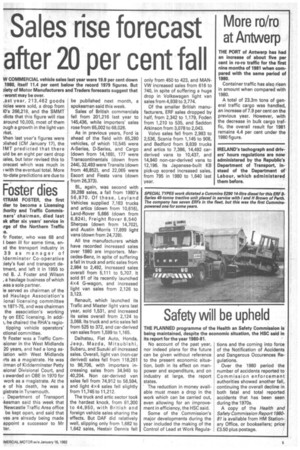Sales rise forecast after 20 per cent fall
Page 5

If you've noticed an error in this article please click here to report it so we can fix it.
W COMMERCIAL vehicle sales last year were 19.9 per cent down 1980, itself 11.4 per cent below the record 1979 figures. But ciety of Motor Manufacturers and Traders forecasts suggest that t worst may be over.
_ast year, 213,462 goods iicles were sold, a drop from 30's 266,218, and the SMMT ,dicts that this figure will rise around 10,000, most of them ough a growth in the light van rket.
Vhen last year's figures were plished (CM January 17), the 1MT predicted that there uld be an eight per cent drop ;ales, but later revised this to orecast which was much in with the eventual total. More to-date predictions are due to be published next month, a spokesman said this week.
Sales of British commercials fell from 201,216 last year to 145,436, while importers' sales rose from 65,002 to 68,026.
As in previous years, Ford is ahead of the field with 65,280 vehicles, of which 10,545 were A-Series, D-Series, and Cargo (down from 14,169), 177 were Transcontinentals (down from 244), 32,493 were Transits (down from 46,852), and 22,065 were Escort and Fiesta vans (down from 26,373).
BL, again, was second with 39,288 sales, a fall from 1980's 56,870. Of these, Leyland Vehicles supplied 7,183 trucks and artics (down from 10,616), Land-Rover 5,666 (down from 6,824), Freight Rover 8,540 Sherpas (down from 14,702), and Austin Morris 17,899 light vans (down from 24,728).
All tne manufacturers which have recorded increased sales over 1980 are importers. Mercedes-Benz, in spite of suffering a fall in truck and artic sales from 2,984 to 2,492, increased sales overall from 5,111 to 5,707. It sold 91 of its recently launched 4x4 G-wagon, and increased light van sales from 2,126 to 3,123.
Renault, which launched its Trafic and Master light vans last year, sold 1,531, and increased its sales overall from 2,124 to 3,068. Its truck and artic sales fell from 525 to 372, and car-derived van sales from 1,599 to 1,165.
Daihatsu, Fiat Auto, Honda, Jeep, Mazda, Mitsubishi, Subaru, and Suzuki all increased sales. Overall, light van (non-car derived) sales fell from 118,261 to 98,706, with importers increasing sales from 34,940 to 40,204. Non car-derived van sales fell from 74,912 to 58,594, and light 4x4 sales fell slightly from 11,745 to 11,212.
The truck and artic sector took the hardest knock, from 61,300 to 44,950, with British and foreign vehicle sales sharing the effects. But DAF did relatively well, slipping only from 1,682 to 1,642 sales, Hestair Dennis fell only from 450 to 423, and MANVW increased sales from 616 to 740, in spite of suffering a huge drop in Volkswagen light van sales from 4,938 to 3,774.
Of the smaller British manufacturers, ERF sales dropped by half, from 2,342 to 1,179, Foden from 1,210 to 535, and Seddon Atkinson from 3,078 to 2,043.
Volvo sales fell from 2,983 to 2,536, Scania from 1,145 to 908, and Bedford from 9,839 trucks and artics to 7,386, 14,492 carderived vans to 10,437, and 14,940 non-car-derived vans to 12,196. Its Japanese-built KB pick-up scored increased sales, from 795 in 1980 to 1,640 last year.










































